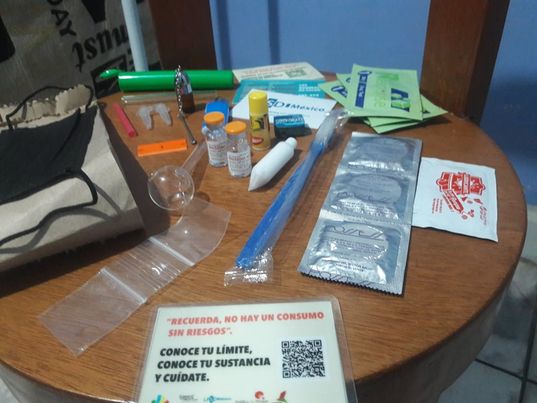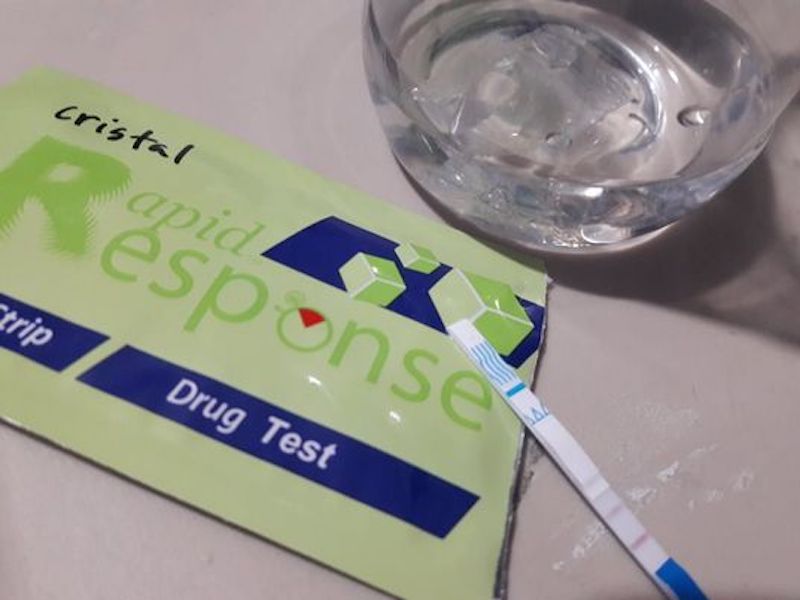In the United States, political discourse around Mexico and fentanyl typically scapegoats the country for producing drugs consumed north of the border. Yet Mexico itself suffers many fentanyl-involved deaths, as Filter has previously reported. However, there is a dearth of data on the drug’s prevalence and related harms. “Drug overdoses are prevalent in low- and middle-income countries but are scarcely reported in the literature,” notes one paper from this year.
To help fill these gaps, some harm reduction organizations in Mexico are working together to gather data on the potential presence of fentanyl in methamphetamine and cocaine. In Canada and the United States, the two popular stimulants are sometimes adulterated with the potent opioid, presenting a high risk of overdose for people without opioid tolerance. But so far, information about this phenomenon is notably lacking in Mexico.
Mexican harm reduction groups argue that in their country, this is due to the federal government’s “discourse that stigmatizes substance use and generates misinformation,” according to one of the organizations involved in the research effort.
“We have no idea how common fentanyl is in stimulants in Mexico, or if there is any geographic factor involved.”
This collaborative research project aims to address this lack of data. Funded through the Drug Policy Program of the Center for Economic Research and Teaching, among others, it involves harm reduction organizations across Mexico—including Verter in Mexicali, Baja California; PrevenCasa in Tijuana, Baja California; and Latin America for a Sensible Drug Policy, Mexico, based in Aguascalientes. The University of Victoria in Canada is also supporting the project.
Liliana García, one of the principal researchers on the project, told Filter that academics, activists, and people with lived or living experiences with drugs are all involved in the innovative study.
“We have no idea how common fentanyl is in stimulants in Mexico, or if there is any geographic factor involved,” she wrote in an email.
The work, which also involves harm reductionists in Mexico City, started last summer. The team began training people who use drugs in the use of fentanyl test strips. They asked that the people use them to test the residues of the drugs they purchase, such as on wrapping or packaging. The researchers then ask participants to report back on whether or not they find any traces of the potent opioid in their drugs. According to García, the team has not been handing out the test strips to any particular demographic, but the recipients are generally people with limited resources.
The fentanyl found in these cities was originally contained in the heroin that people have mixed into their stimulants.
García said that the team is still collecting samples. The researchers originally hoped to obtain at least 100 samples from each participating city, but have since surpassed that total in every case. All of the samples they’ve received from Aguascalientes have so far come up negative for fentanyl, she said. But fentanyl has been present in a number of cocaine and methamphetamine samples from Tijuana, Mexicali and Mexico City.
However, according to García, the fentanyl found in these cities was originally contained in the heroin that people have mixed into their stimulants to create a “speedball.” So far, no samples that were purchased just as meth or coke have been adulterated with fentanyl, she said. As the results are still preliminary, it’s still too early to say why Aguascalientes hasn’t produced any samples containing fentanyl.
Besides the epidemiological data it could provide, the program is also geared towards encouraging safer drug use in the cities. García wrote that the work can be used to foster new harm reduction strategies—particularly in places like Aguascalientes, which, compared to the other cities involved in the study, has relatively few harm reduction resources.

The team also recently began handing out kits that contain a variety of other useful harm reduction tools—glass pipes, condoms, lubricants, straws, etc—as well as the fentanyl test strips. The kits additionally contain written materials on the safe consumption of stimulants and a telephone card worth 200 Mexican Pesos. The team had wanted to hand the kits out with the test strips from the start, but that plan was held up. “The delay was administrative and budget issues, but the goal is to distribute at least one hundred kits per city,” García wrote.
The report’s findings have yet to be published, but the team will present the results at a Drug Policy Program seminar in May. This gives them more time to continue collecting samples and distributing the kits. According to García, they hope to make the testing and distribution program permanent, but would require new funding to do that.
Photographs courtesy of Liliana García.
The Open Society Foundations, one of the funders of the project in Mexico, has also provided a restricted grant to The Influence Foundation, which operates Filter.





Show Comments